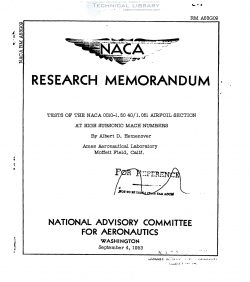naca-rm-a53g09
- Version
- 98 Downloads
- 761.16 KB File Size
- 1 File Count
- August 13, 2017 Create Date
- August 13, 2017 Last Updated
National Advisory Committee for Aeronautics, Research Memorandum - Tests of the NACA 0010-1.50 40 1.051 Airfoil Section at High Subsonic Mach Numbers

Aerodynamic characteristics of the NADA OOlO-l.50 h0/l.05l air—
foil section have been determined from wind—tunnel tests at Mach numbers
from 0.3 to 0.9. The corresponding Reynolds number variation was from
approximately 1 X 106 to 2 x 105. These results for an airfoil with a
leading-edge radius of 1.50 percent of the chord are compared with those
of a previous investigation of the effects of leading—edge-radius vari-
ation from 0.27 to 1.10 percent of the chord on the characteristics of a
lO-percent-thick, symmetrical airfoil section at high subsonic Mach
numbers.
The comparison indicates small increases of the Mach numbers for
lift and drag divergence at low lift coefficients for the section with
the largest leading-edge radius.
In reference 1, the effects of systematic reduction of the leading-
edge radius on the variation with mach number of the aerodynamic charac-
teristics of a lO-percent-thick, symmetrical airfoil section.were
reported. To examine the effects of an increase in leading-edge radius
for the same airfoil section, the present investigation was undertaken
in the Ames l? by 3-1/2-foot high-speed wind tunnel. The airfoil is of
the modified NACA four-digit series (see ref. 2), with maximum thickness
at the hO-percent-chord position and with a trailinghedge angle of 12°.
In the present instance the airfoil leading-edge radius is 1.50 percent
of the chord; whereas in reference 1 the radii were 1.10, 0.70, and 0.27
percent of the chord. To facilitate comparison, the results of refer-
ence l are reproduced in the present paper.
The airfoil section of the present investigation is designated as:
NACA OOlO—l.50 h0/l.051. The first digit of the airfoil designation indi—
cates the camber in percent of the chord; the second, the position of the
camber in tenths of the chord from the leading edge; and the third and
fourth, the maximum thickness in percent of the chord. The decimal number
following the dash is the leading—edge-radius index; the leading-edge
radius as a fraction of the airfoil chord is given by the product of the
radius index and the square of the thickness-chord ratio. A radius
index of 1.10 is standard for the NACA fourfdigit—series airfoil sections.
The two digits immediately preceding the slant represent the position of
maximum thickness in percent of the chord from the leading edge. The
last decimal number is the trailing-edge-angle index, the angle being
twice the arc tangent of the product of the angle index and the thickness—
chord ratio.
The coordinates of the airfoil investigated are given in table I.
This airfoil profile is illustrated in figure 1 along with those of
reference 1 to show the influence of leading-edge radius on profile
shape.
| File | Action |
|---|---|
| naca-rm-a53g09 Tests of the NACA 0010-1.50 40 1.051 Airfoil Section at High Subsonic Mach Numbers.pdf | Download |
Comment On This Post